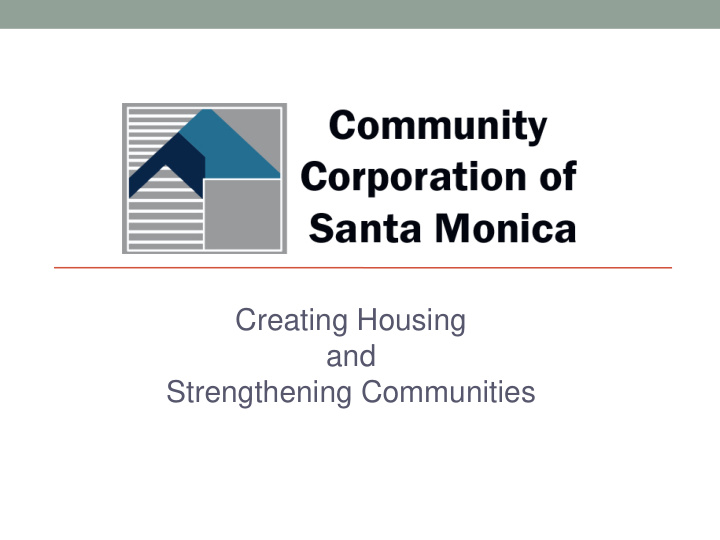



Creating Housing and Strengthening Communities
Key Topics • Brief History of CCSM • Summarize Portfolio • Financing Sources • Next Steps
Introduction CCSM is a private not-for-profit organization that was incorporated in 1982 by community leaders who sought to preserve Santa Monica’s social and economic diversity by providing affordable housing. 33 years later, CCSM remains true to its mission. “We exist for the charitable and public purpose of providing individuals and families with economic opportunity by developing and managing affordable housing for people with low and moderate incomes.”
How CCSM is Organized • Board of Directors • Representatives from Neighborhood Organizations • Professionals (lawyer, accountant, real estate consultant, etc.) • Staff in 5 Departments (50 full-time; 39 part-time) • Housing Development • Property Management • Maintenance • Resident Services • Accounting
2602 Broadway National AIA Award - 2015
Statistics about CCSM’s Portfolio • Currently own and manage 1,684 units • 996 are acquisition/rehabs (59% of units) • 688 have been newly constructed (41% of units) • Newly constructed properties range in size from 4 to 47 units (average of 26 units in 26 buildings) • Rehabilitated properties range in size from 4 to 62 units • About 50% of CCSM’s units are Rent Controlled • Per Costa-Hawkins rents can increase to market for new vacancies • CCSM cannot raise rents to market due to rent/income restrictions
Existing Multifamily Properties
Affordable Housing Production
# of Units 100 120 140 160 180 20 40 60 80 0 1983 1984 1985 1986 Affordable Housing Production Over Time 1987 1988 1989 1990 1991 1992 1993 1994 1995 1996 1997 1998 Year 1999 2000 2001 2002 2003 2004 2005 2006 2007 2008 2009 2010 2011 2012 2013 2014 2015 Rehab New
Populations Served • CCSM serves households with modest incomes • Step-Up provides supportive housing for homeless persons • 10+ different organizations provide housing for seniors • 270 of CCSM households (16%) have a voucher • Sec. 8 vouchers & other operating subsidies provided by the City • Shelter + Care Operating Subsidies • Veterans Affairs Supportive Housing (VASH) vouchers • 25% of people living in CCSM buildings are aged 55+ • 26% are under the age of 18 • A total of 3,925 people live in CCSM properties
Overview of Sources • Conventional Debt • Federal Programs • State Programs • Local Programs
Conventional Debt • First mortgage from a conventional lender, typically Bank of America or Citibank • Banks are motivated to lend to comply with the Community Reinvestment Act (CRA) • Construction loans – floating interest rates • Permanent loans – fixed rates for 30 years
Federal Programs • Low Income Housing Tax Credits (LIHTC) • Tax Reform Act of 1986, Sec. 42 of Internal Revenue Code • Dollar for dollar reduction in the tax liability for investors • Housing & Urban Development (HUD) • Community Development Block Grant (CDBG) • HOME Investment Partnerships (HOME) • Operating Subsidies like Section 8 and Shelter + Care • Amount of Federal Housing Subsidies in FY2012 • $120 billion in mortgage interest and property tax deductions for homeowners • $47.5 billion for rental housing programs targeting low and moderate income people.
State Programs • Equity • California Tax Credit Allocation Committee (TCAC) • 9% LIHTCs – a competitive process and local funds are critical • 4% LIHTCs - automatic if Tax-Exempt Bonds are awarded • Debt • Tax-Exempt Bonds awarded by the California Debt Limit Allocation Committee (CDLAC) • CA Dept. of Housing and Community Development (HCD) • Multifamily Housing Program (MHP) • California Housing Rehab Program (CHRP) • Rental Housing Construction Program (RHCP)
Local Programs • Redevelopment Housing Trust Fund (HTF) • Approx. $15 million in annual funds permanently eliminated • CDBG HTF (federal) • HOME HTF (federal) • TORCA HTF (local) • Tenant Ownership Rights Charter Amendment • Citywide HTF (local) • Sources include AHPP in-lieu fees, Development Agreements and specific events such as the sale of City-owned property
Local Sources before Elimination of RDA Redevelopment All others
Local Funding for Housing
Definition of Rent & Income Levels • Govt. funding sources impose limits on the rent CCSM can charge & max. income of a household • Household income cannot exceed certain levels • Rents are set at levels that relate to AMI • Extremely Low Income = 30% of AMI • Very Low Income = 50% of AMI • Low Income = 60 to 80% of AMI • Moderate = 80 to 120% of AMI • Rents correspond to income levels • Rents set at 30% of maximum income • Rents increase gradually at rates allowed by HUD, other funding sources and/or Santa Monica’s Rent Control Board
Goals for Moving Forward • Acquisition/Rehabs • Antidote to Costa-Hawkins: CCSM doesn’t mark-up to market, instead rents are reduced to affordable levels • New Construction • Cap & Trade / Transit Oriented Development • Potential Statewide Housing Trust Fund (AB 1335 – Atkins) • Enhance Sustainability • Save Water • Reduce use of Electricity • Partner with Other Entities • Develop AH for another entity to fulfill inclusionary obligation • JV with a developer (similar to partnership with Related at Bel Mar) • Partner with other entities to serve a specific population (Veterans)
Next Steps • Local funding essential to leverage other funds for AH • To compete for LIHTCs, leveraging of local funds is critical • Cap & Trade is expected to be a significant ongoing source of state funding for AH and leveraging will be important • Housing Advocates in LA County have undertaken a multi-year effort to have the BOS commit 50% of former RDA funds to AH • Establish an evergreen source of funding for AH • Enhanced Infrastructure Financing District? • 55% popular vote vs. 67% • Need support of County Board of Supervisors • Ballot measure in 2016? • Other sources of local funds for AH
High Place West Completed in Nov 2012
QUESTIONS?
Recommend
More recommend